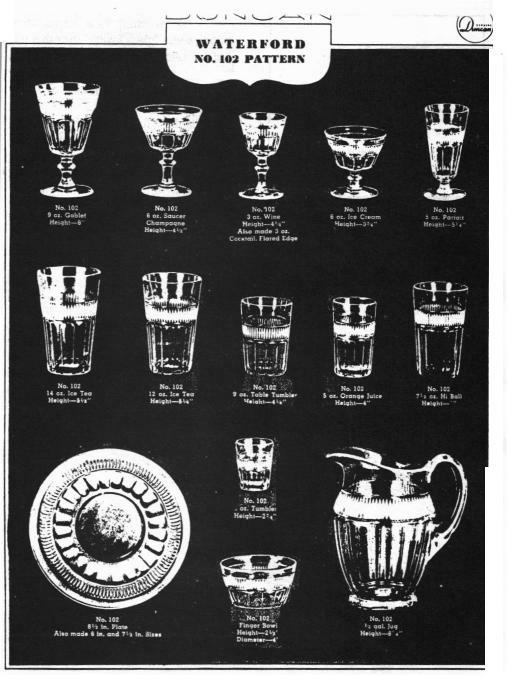National Depression Glass Association
Preserving America's Glass Manufacturing Heritage
Duncan & Miller's Waterford
by Gail Krause
Glass Review - September 1987
 Most collectors of Duncan and Miller glassware are familiar with the
First Love, Teardrop and Adoration patterns, but some of the earlier
pressed patterns go unrecognized in the shops and flea markets.
Most collectors of Duncan and Miller glassware are familiar with the
First Love, Teardrop and Adoration patterns, but some of the earlier
pressed patterns go unrecognized in the shops and flea markets.
Waterford is one such lovely pattern. Although produced in the late 1930s it may still be found and purchased at bargain prices.
 Waterford was manufactured in a complete line of tableware. Included
were plates, cups, saucers, finger bowls, salt and pepper shakers,
cream and sugar sets, as well as a full line of stem ware. This glass
combines sturdiness with an unusually high brilliance. Colors found
include clear, green, cobalt and ruby.
Waterford was manufactured in a complete line of tableware. Included
were plates, cups, saucers, finger bowls, salt and pepper shakers,
cream and sugar sets, as well as a full line of stem ware. This glass
combines sturdiness with an unusually high brilliance. Colors found
include clear, green, cobalt and ruby.
The Duncan and Miller Company was known for superior pressed ware and this pattern is a typical illustration. Fourteen men were required to make each individual piece, every operation required great skill and experience.
In the first stage the mold was made from cast iron, with each line or dot of every pattern cut by hand with a chisel and hammer. Prior to this wooden molds were used, but later iron proved more satisfactory.
When the molds were put on the press, a gathering boy gathered molten glass from the furnace on a punty. He carried this to the presser who cut off the correct amount with a pair of shears. The presser bore down on a plunger which squeezed the glass into every crevice of the mold.
Another worker attached this still red-hot glass to the end of another iron rod and placed it into the furnace, or "glory hole", where he twirled the glass rapidly. Just before the glass was hot enough to lose its shape, it was taken out and given to another worker who formed the heated glass with a wooden paddle until it took its final shape. Following this step it was placed into an annealing furnace where it remained for several hours cooling very slowly in order to give resistance and endurance to shock.
Considering the labor and time involved making old pressed glass, it is easy to understand why pressed patterns were often the most highly prized of early American glass antiques. When you view a finished product, such as the Waterford pattern, you'll agree with Duncan's motto "the Loveliest Glassware in America".